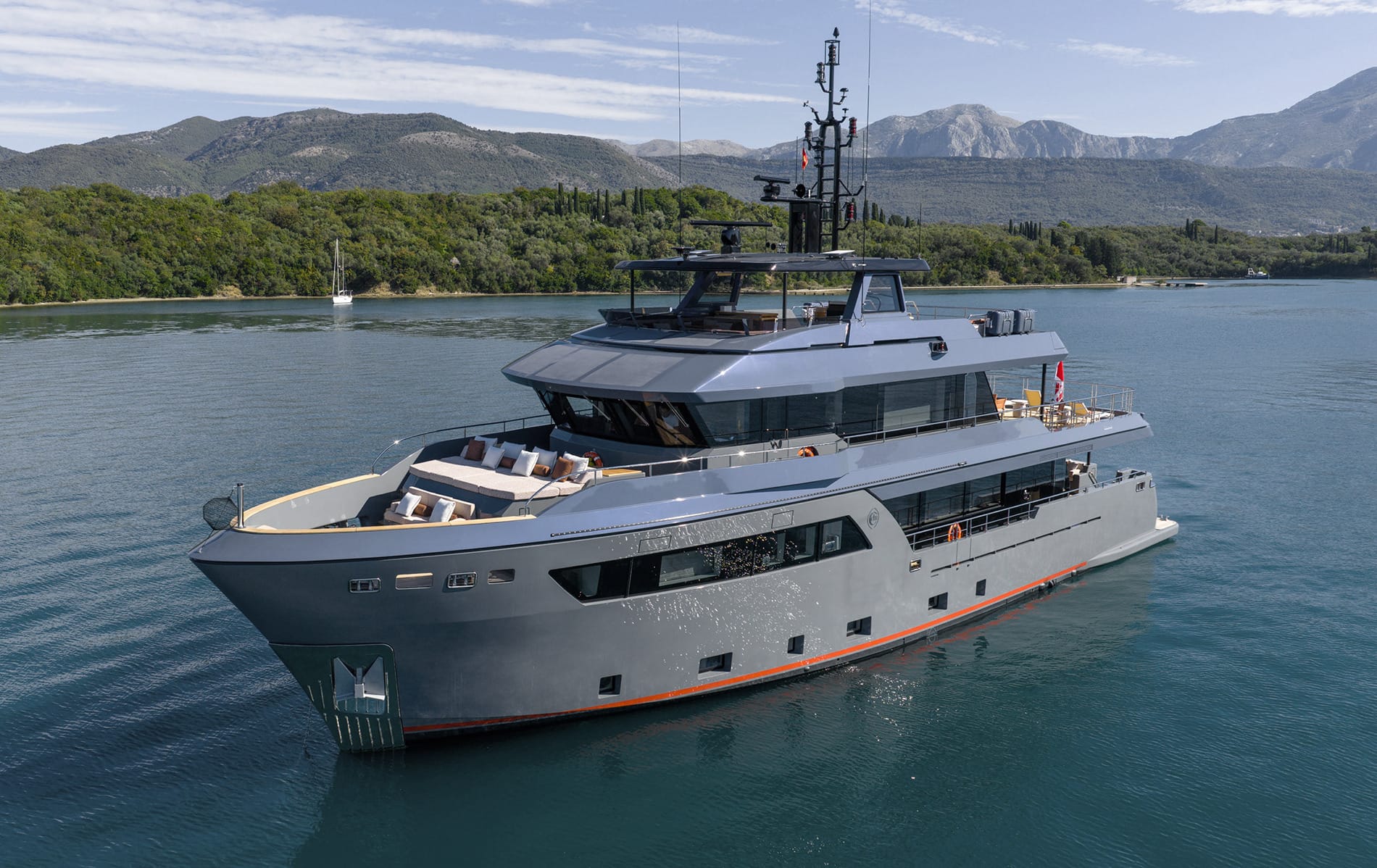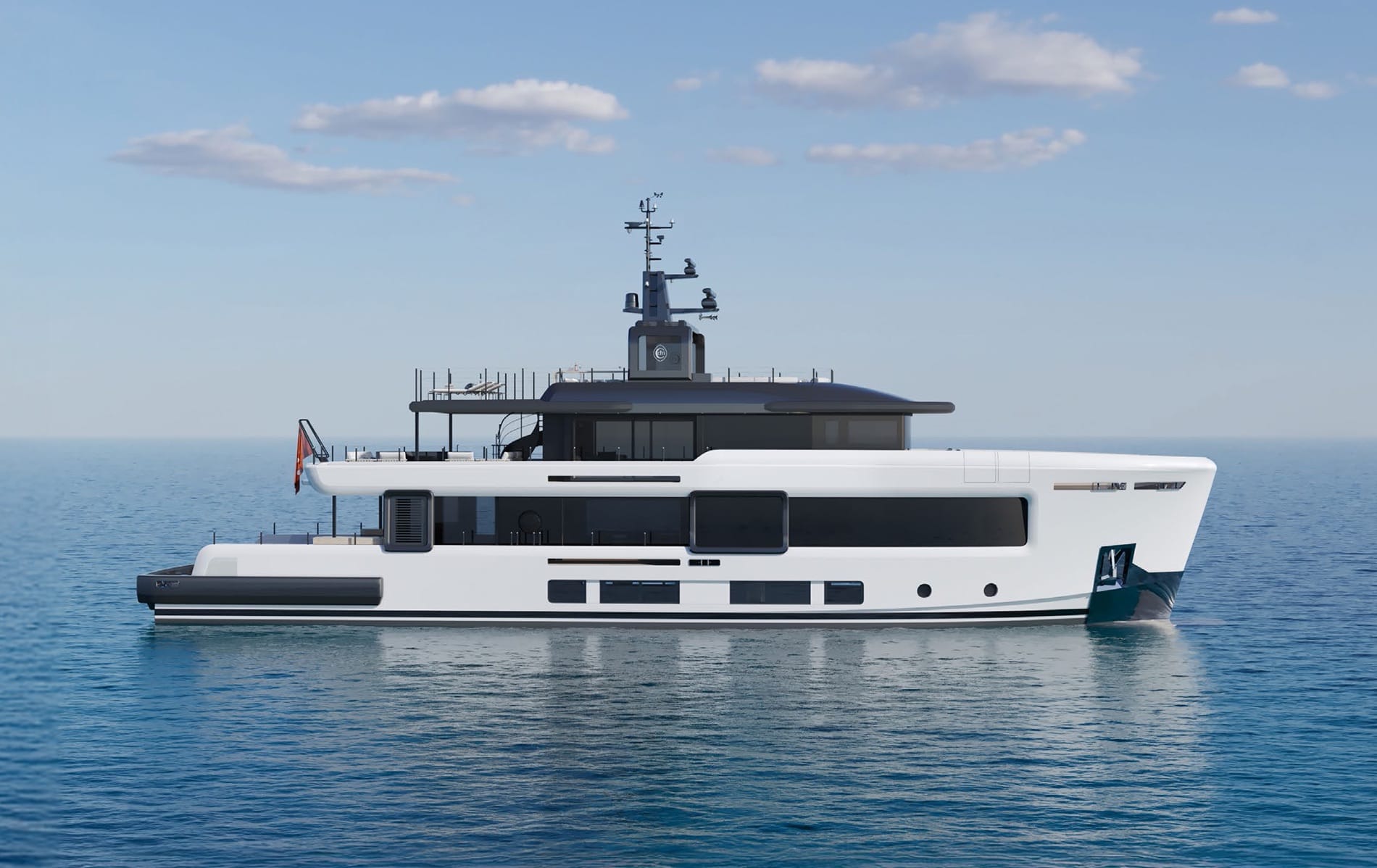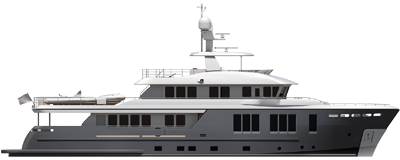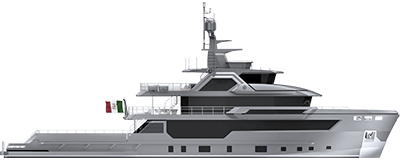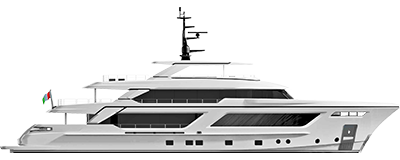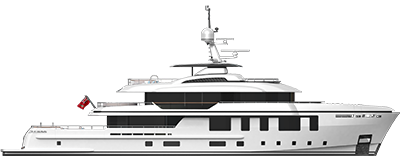Go anywhere
do anything
If there were any doubt that the owner of Percheron — the second Darwin 86' from Cantiere delle Marche (CdM) — really intended to use his expedition yacht for long-range cruising, there should not be any now. Percheron was launched in time for the 2012 Cannes Boat Show where I had a chance to get aboard. It was mid-September and she was already raring to go.
As my guide lifted the stairs to show me the large storage area underneath, she uncovered numerous packages and boxes. “They are already loading up for their transatlantic crossing,” she said by way of an apology. But that was unnecessary. What is more cheerful than a boat and a crew about to embark on a great adventure? On October 9, 2012, Percheron cast off with her belly full of supplies and her passengers full of anticipation. “As we go into the night we have our last view of land for the next two weeks. It’s a strange feeling as we know we are heading across 3,500 nautical miles of open ocean with depths of over 4.5 kilometers. There can be strong winds, big waves and big fish out there. However, this doesn’t scare us. We have waited for this moment for a long time now, and we feel extremely grateful for the adventure and experience,” reads the first entry on the ship’s blog.
The yacht’s solid grade-A steel-hull construction and sound engineering go a long way to provide a feeling of safety, even on the longest passages. The owners have plans to explore far and wide. After the Fort Lauderdale International Boat Show, their cruising plans call for sightseeing around the Bahamas and, after the Palm Beach International Boat Show where the boat will be on display, they will head south to the Galápagos, Cape Horn and then the Indian Ocean. “There are not too many 86-footers with a range of 7,000 nautical miles,” says Simon Gibson of Worth Avenue Yachts. “She can do anything and go anywhere.” The Palm Beach-based brokerage firm, which represents CdM in the Americas, introduced Percheron’s owner to CdM’s director of sales and marketing, the assionate and effusive Vasco Buonpensiere. “Call it serendipity,” Gibson says. “We introduced them two hours after our first meeting with Vasco.”
Buonpensiere is a great ambassador for the brand and the relatively new shipyard, located on Italy’s Adriatic coast. His enthusiastic presentation to the Worth Avenue Yachts partners in February 2011 convinced them they’d found the right shipyard, products and level of service for a yachting clientele that is proving even more choosy than a few years ago. The investors behind the shipyard (see the August edition of Yachts International) have extensive experience in commercial shipbuilding. An interesting and intelligent setup made the yard’s important subcontractors part owners, so they have a vested interest in the quality of the work. When they launched into this new adventure, the CdM team zeroed in on the explorer style. Percheron’s owner has had boats before this one, but this is the first true expedition yacht he’s operated. He is keen on sharing the experience with his crew. The yacht’s inviting interior reveals the journey will be a communal experience among all passengers. The well-equipped and pleasant galley is located right across the crew mess on the main deck. Large, comfortable and equipped with a big settee, real table and washer and dryer, this area compares favorably with any crew mess on a superyacht, and is in some ways better—its location on the main deck (where the crew cabins are also located) guarantees the crew will not feel confined during long passages. Early on during the journey, a blog post shows deckhand Alessandro d’Emarese making hamburgers for lunch. A similar layout is on Hull No. One, No. 2 (Percheron) and the third Darwin 86, says Gibson, but the interior can be organized differently, and this helps set CdM apart. “There are only a few steel builders in this size range that go to this level of customization,” he says. Percheron differs from Hull No. 1 (called Vitadimare 3) in several ways. For instance, the owners removed one large walk-in wardrobe from the master stateroom, which created space for a large working desk and shelves to provide them with a generous office space. But in spite of a number of differences, including a different paint scheme, the first two Darwin 86s are more alike than they are different. They are solid ships with a modest length but great volume, thanks to a generous beam and four decks.
I met Buonpensiere aboard while the boat was in Cannes. After I walked across the gangway, he encouraged me to linger on the aft deck. My first reaction was surprise—apparently a typical one from first-time visitors. The aft deck feels huge, owing to the boat’s maximum beam of 24 feet 37 inches (or 7.43 meters). “She is under 24 meters, but she is big. Even from the dock, there is a kind of wow effect. From the second they board, people feel there is something different and it is not just about the lines,” Buonpensiere says, referring to the boat’s tug-like styling.
The boat feels solid and sturdy. With her round-bilge steel hull, aluminum superstructure and zero-speed fin stabilizers, Percheron is not given to much rolling at anchor. While the yachts around us move as we chat on the aft deck, she does not budge. From the aft deck, Buonpensiere takes me down to the engine room. The lazarette is an impressive entryway into the underbelly. The 1,800-gallon-a day watermaker, a great vertical drill and work space for all reparations on board and on this hull, a practical second washer and dryer set are a few of the highlights.
I have seen shinier engine rooms but hardly better. Spacious, well laid out, ventilated and insulated, it features proven and easily accessible systems. It exemplifies the shipyard’s philosophy of “building a boat engineering up and not interior down,” as Gibson puts it. Instead of the polished stainless steel that many shipyards use in a yacht’s engine room, CdM has taken a more practical approach of chemically treated and painted 5-millimeter-thick steel plates, which are easy to maintain but show off leaks or dirt easily. Buonpensiere talks about the yard’s no-frills approach, and it is evident here. “This is a shipping approach to engineering,” he says. The shipyard has adopted systems from commercial and passenger ships that do thousands of miles every year over some of the brands common among the yachting set. There is a bilge-oil treatment, which is standard. All the valves and bilges are automatized, so the captain or engineer can transfer fuel or open and close the bilges from the bridge.
What this means, aside from reliability, is that the boat will be well maintained, since everything is so easily accessible. Few of the owner’s guests will get to see the engine room, but they will appreciate the ship topside—the inviting elm veneer and oak flooring, beautifully finished cabinets, large windows and easy accesses. The interior is fresh and open, but also practical. Still, it is likely to stir an emotional response. “Imagine when a friend comes here,” Buonpensiere says as we enter the beautiful and professional bridge. We have great views all around, and from here again, the boat feels very big. A banquette offers great seating behind the leaning post.
Aftare the captain’s cabin, a comfortable skylounge and an aft deck able to handle a 20-foot tender and a 2,205-pound (1.1-ton) crane. A few more steps up, and we reach the sun deck. I venture to imagine what it might feel like to kneel on the soft cushion, leaning over the guardrail and approaching an island of the Galápagos.
Lucky for them, the owners of Percheron will find out soon.

